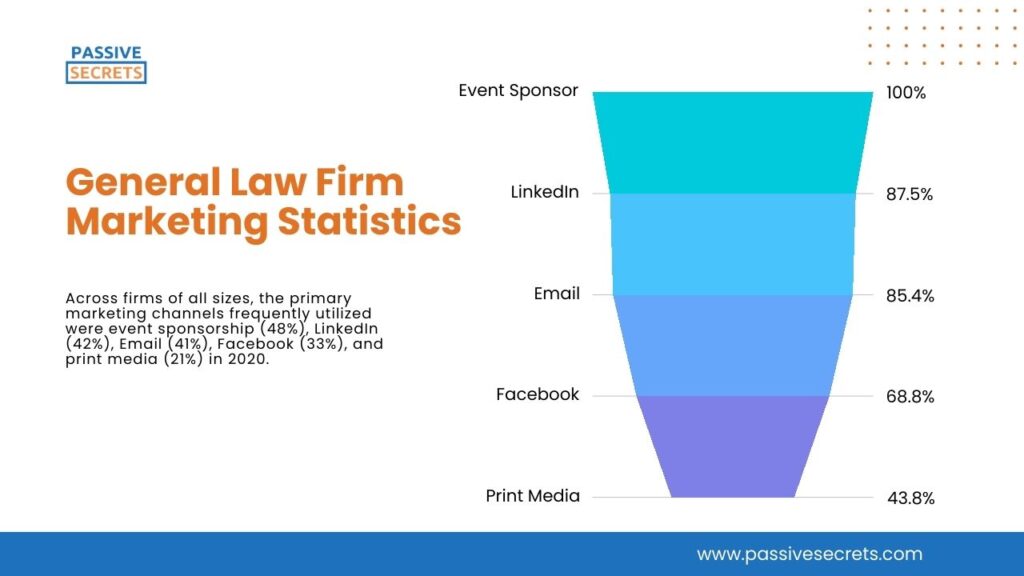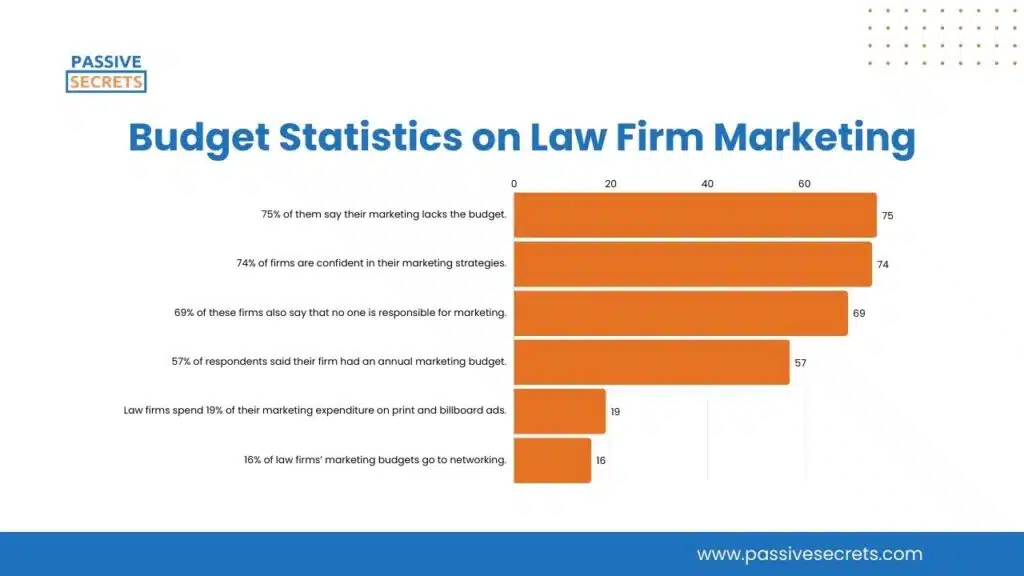
Did you know that over 1/3 of potential clients initiate their attorney search online? This emphasizes the importance of a strong online presence in today’s legal market.
Law firms must actively navigate the digital arena to stand out and flourish.
If you’ve recently opened a private practice or want to attract more clients to your existing business, you should consider law firm marketing.
At the same time, you may be afraid to get started because you are unsure if the investment will be beneficial; well, you’re not alone!
In this article, we provide you with compelling statistics to boost your legal practice.
While also learning valuable insights to attract more clients and achieve success.
Key Law Firm Marketing Statistics (Editor’s Pick)
- 39% of firms said they plan to increase their marketing efforts.
- 47% of law firms plan to adopt web/marketing analytics technology.
- The worldwide legal services industry is expected to be worth over U.S. $797 billion.
- 70% of law firms stated that social media is an integral part of their overall marketing plan.
- 96% of people seeking legal advice use a search engine.
- For 65% of legal firms, online marketing accounts for the majority of the marketing budget.
- Law firms spend 19% of their marketing expenditure on print and billboard ads.
- Only 24% of respondents stated their firms used video for marketing, with larger firms using it more frequently.
General Law Firm Marketing Statistics
1. 39% of firms plan to increase their marketing efforts. 33% will do it next year, 7% will reduce marketing efforts, and 21% are unsure. (source)
2. Across firms of all sizes, the primary marketing channels frequently utilized were event sponsorship (48%), LinkedIn (42%), Email (41%), Facebook (33%), and print media (21%) in 2020. (source)

3. 58% of respondents believe that a lack of marketing effort has a negative impact on a company’s market performance. (source)
4. Many law firms use remarketing to stay in touch with both unconverted prospects and current clients. (source)
5. Those who use remarketing methods report spending 49% of their marketing budget at this stage of the sales funnel. (source)
6. The most prevalent remarketing strategies are targeted content (46%), check-in calls (46%), and special occasion greetings (45%). (source)
7. For 83% of surveyed respondents, outsourcing marketing work allows law firms to focus on their strengths. (source)
8. According to 89% of firms, marketing is more closely scrutinized than billable activities due to its non-billable nature. (source)
9. 70% believe their firm has wasted money on low-ROI marketing campaigns in the last 12 months. (source)
10. 47% of law firms plan to adopt web/marketing analytics technology. (source)
11. 21% of law firms say the first contact with a prospect is via phone or online portal. (source)
Another 20% of law firms say the first contact with a prospect is via email.
12. In the same survey, 36% of law firms say clients prefer phone calls. (source)
Another 22% say clients prefer text messages, while 15% say clients prefer email.
13. 81% of firms say they’re across the client journey recording phone calls. (source)
14. The majority (55%) of law firms use call recordings to inform marketing decisions and messaging. (source)
48% of firms say call recordings help them populate intake information.
15. Since 2012, the growth of demand for law firm services has been stagnant and continued to be flat in 2019. (source)
16. The average revenue growth rate in the legal market in 2019 was 5.4%. (source)
17. In 2019, the industry’s average billable hours were 123 hours. (source)
18. The typical legal service prices increased by 4.4% in 2019. (source)
19. In 2023, the worldwide legal services industry is expected to be worth over U.S. $797 billion. This represented an increase of almost U.S. $9.5 billion over the previous year. (source)
20. In 2017, the United States accounted for almost half of the global market and Europe for just over one quarter. (source)
21. Growth in the Asian law firm market is expected to outpace that of North America and Europe over coming years. (source)
22. The global legal services market experienced growth from $713.66 billion in 2020 to $734.56 billion in 2021 at a compound annual growth rate (CAGR) of 2.9%. (source)
23. Productivity in the industry fell back to negative growth at -2% in 2019, reversing performance in 2018. (source)
24. Law firms often prioritize existing clients over new leads. (source)
Social Media Marketing Statistics For Law Firms
25. 70% of law firms stated that social media is an integral part of their overall marketing plan. (source)
26. The statistics reveal that a significant majority of law firms, approximately 84%, are successfully generating leads through organic social media traffic. (source)
27. 11% of law firms were most optimistic about their performance in social media management. (source)
28. 96% of people seeking legal advice use a search engine. (source)
29. 37% of firms are leveraging LinkedIn advertising. (source)
30. Respondents reported that their firms’ use of Twitter, direct mail, Avvo, Findlaw, Lawyers.com, or the Yellow Pages to market their practices was at 16% or less. (source)
31. Solos reported using email (28%), LinkedIn (28%), event sponsorship (23%), and Facebook (20%) as major channels. (source)

32. Firms of 2-9 lawyers use event sponsorship (45%), Facebook (37%), LinkedIn (35%), and email (31%). (source)
33. In firms of 10-49 lawyers, event sponsorship also ranked highest at 62%, followed by email at 49%. (source)
34. A majority of both law firms and individual lawyers have some online presence through social media. (source)
35. 81% of respondents say that their firms maintain a presence on at least one social media platform (the highest since 2016). (source)
36. 77% say that they participate on at least one social media platform for professional purposes themselves. (source)
37. Among those firms that do use social media, LinkedIn is still the leading platform at 76%, followed by Facebook (60%), Twitter (37%), Martindale (35%), and Avvo (22%). (source)
38. In 2018, 63% of respondents reported their firms maintained a Facebook presence, and 36% maintained a presence on Avvo. (source)
39. Instagram has quickly become one of the most popular platforms for non-professional use, but it sees little use by law firms, and no solos report using the platform for their firms. (source)
40. According to the LexisNexis survey, over 90% of law firms with five or fewer attorneys plan to use a professional social network such as LinkedIn. (source)
41. Research conducted by BT Consulting examining the use of legal directories and online lawyer profiles found that among all in-house counsel, from general counsel to staff attorneys, 98 percent were familiar with LinkedIn. (source)
SEO Marketing Statistics For Law Firms
42. The average law firm experiences an impressive 526% return on investment (ROI) from its SEO efforts over a three-year period. (source)
43. SEO was rated as the most effective channel for marketing and gaining clients by 79% of surveyed legal professionals in a law firm study by BrandMuscle in 2020. (source)
Statistics on Other Marketing Strategies
44. Only 31% of lawyers surveyed stated that their firms use videos to promote the practice. (source)
45. Respondents from firms with 100 lawyers were more likely to report that their firm produced video (47%), as compared with fewer than 25% of respondents from firms of other sizes. (source)
46. In 2020, only 24% of respondents stated their firms used video for marketing, with larger firms using it more frequently. (source)
47. 27% of firms with 10-49 lawyers and 23% of firms with 2-9 lawyers report using video. (source)
48. 67% of those who produce videos keep them on their company’s website, 32% on YouTube, and only 3% on Vimeo. (source)
49. For 65% of legal firms, online marketing accounts for the majority of the marketing budget. (source)
50. Legal marketers identified Email marketing as the #1 underperforming channel. (source)
51. 96% of firms said they engage in paid search marketing, or pay-per-click (PPC). (source)
52. 97% of law firms who use PPC say paid search is too expensive to get good ROI. (source)
53. 80% of law firms are leveraging webinars. (source)
54. 38% of law firms have podcasts. (source)
55. PPC advertising is important because 85% of prospective clients prefer using Google as their primary source for research when looking for a lawyer. (source)
56. 59% of law firms desire to spend more on marketing strategies like paid search but donʼt have the budget to compete with larger firms for priority. (source)
Law Firm Website Statistics
57. 37% of respondents report their law firms maintain a blog. This includes 45% of lawyers in firms with 100-499 lawyers and over 70% of respondents from firms with 50-99 or 500+ lawyers. (source)
58. 45% of a law firm’s new clients visit their firmʼs website. (source)
59. New cases have been acquired by 70% of legal firms via their websites. (source)
60. 40% of small law firms do not have websites. (source)
61. 35% of small firms with websites haven’t updated them in the last three years. (source)
62. 68% of respondents said that their website is mobile-friendly. (source)
63. The majority of law firm websites feature profiles of partners (98%) and associates (73%), with nearly half providing details on handled cases, such as recent successes and cases of interest. (source)
64. 23% of firms with websites claim that an outside consultant mostly manages their websites, while 21% are controlled by a single lawyer within the firm. (source)
65. 32% of respondents, including 36% of solo practitioners and respondents from legal firms with 10–49 professionals, said that clients used their website to make hiring decisions. (source)
66. Of the online channels law firms can allocate budget toward, the most popular channels are websites (24%), paid advertising (18%), and SEO (17%). (source)
Budget Statistics on Law Firm Marketing
67. 57% of respondents said their firm had an annual marketing budget. (source)
68. Lack of budget is a leading reason law firms donʼt outsource any of their marketing. (source)
69. 74% of firms are confident in their marketing strategies. (source)
Of these firms, 75% of them say their marketing lacks the budget. 69% of these firms also say that no one is responsible for marketing.
70. Law firms spend 19% of their marketing expenditure on print and billboard ads. (source)
71. 16% of law firms’ marketing budgets go to networking. (source)

Law Firm Marketing Trends
In 2024, law firms will change how they attract clients. They will use new methods, such as online marketing, personalized content, and technology like AI, to better connect with people.
These trends help law firms stand out and build better relationships with clients. Let’s explore the exciting trends shaping legal marketing in 2024!
1. Quality Content
Content will always be the vital component that powers a business’s marketing machine.
Law firms are starting to realize that it’s more beneficial to spend money on a few high-quality pieces of content per quarter than on dozens of low-quality items.
Law firms should prioritize creating engaging and valuable content that resonates with their audience, particularly potential clients.
Effective content marketing goes beyond mere keyword optimization for SEO purposes. It must cater to both human readers and search engine algorithms, placing a stronger emphasis on providing value to the audience.
2. Integrate SEO And Brand Reputation To Dominate Search Results

By aligning SEO strategies with a strong brand reputation, law firms can dominate search results effectively.
SEO ensures that a law firm’s digital presence is optimized for search engines, making it more discoverable by potential clients.
Conversely, a solid brand reputation establishes credibility and trust, enhancing a law firm’s online visibility.
Law firms need to focus on creating quality content that showcases their legal expertise while incorporating strategic keyword usage to drive traffic to their websites.
By combining SEO practices with a strong brand reputation, law firms can ensure a seamless user experience that aligns with customer expectations and fosters lasting connections.
3. Digital Advertising And Social Media
Digital advertising and social media platforms are undergoing a revolutionary change toward interactive and client-centric techniques.
Here, the core of a law firm’s voice comes into play, giving clients a sense of the values and personality of their possible legal counsel.
Google’s algorithms continue to demand relevance, forcing firms to fine-tune their SEO strategies to remain visible in an increasingly congested online landscape.
Firms aware of these developments will be able to stay up with and even outperform competitors for industry leadership.
4. Integration of AI
With the advancement of AI tools in 2023, law firms would benefit from understanding how to use them to improve their online presence.
AI enables law firms to anticipate market trends and client needs, automate client interactions with tools like chatbots, and enhance CRM systems for better client relationship management.
This integration transforms client interactions, data analysis, content optimization, lead generation, marketing campaigns, and CRM enhancement.
Hence, there is increased efficiency, improved client relationships, and a competitive advantage.
Final Thoughts
These law firm marketing statistics show a vivid picture of the critical role that digital marketing plays in the success of law firms today.
As more potential clients turn to online channels to search for legal services, it’s clear that law firms that prioritize their online presence and invest in digital marketing strategies are best positioned to thrive in the field.
By leveraging the power of social media, search engine optimization, and other digital marketing tactics, law firms can attract new clients, build their brand, and position themselves for long-term success.
Frequently Asked Questions
1. How do you do marketing for a law firm?
To market a law firm effectively, you can identify your target audience, understand their needs, and create a strong brand identity that is consistent across all marketing channels. Then, optimize your website to be user-friendly, mobile-responsive, and SEO-friendly, and use social media to connect with potential clients and share valuable content.
2. Do law firms need marketers?
Yes! Law firms do.
3. How can law firms measure the success of their digital marketing efforts?
Law firms can measure the success of their digital marketing efforts by tracking metrics such as website traffic, conversion rates, email open rates, and social media engagement.
4. Why do law firms need digital marketing?
Law firms need digital marketing because most potential clients search for legal services online. A strong online presence is also necessary to compete in today’s digital landscape. Digital marketing provides data and analytics to track the effectiveness of marketing efforts.
5. How much should lawyers spend on marketing?
According to the American Bar Association, a typical range for marketing budgets in law firms is 2-5% of gross revenue. However, this can vary depending on the firm size, competition in the market, and budget. You can also consider your marketing goals and objectives.
6. What are the most effective digital marketing strategies for law firms?
Some of the most effective digital marketing strategies for law firms include search engine optimization (SEO), social media marketing, email marketing, and content marketing.
7. Why is having a strong online presence important for law firms?
A: A strong online presence is crucial for law firms because potential clients often search for legal services online. With a well-designed website, engaging social media profiles, and a strong search engine ranking, law firms can attract more potential clients and build their reputation.
8. How can law firms stay current on digital marketing trends?
Law firms can stay current on the latest digital marketing trends by reading industry blogs and publications, attending marketing conferences and events, and following thought leaders.

Other Statistics Posts:
- B2B Sales Statistics: Latest Insights and Trends
- 50+ Essential Traditional Marketing Statistics & Trends
- 60+ QR Code Statistics, Usage, Forecasts & Trends
- 90+ Useful Marketing Jobs Statistics & Facts (Latest Report)
- Sales Enablement Statistics: Data You Need to Drive Sales Growth
- In-store vs Online Shopping Statistics And Analysis
- Social Media Addiction Statistics
- Latest In-Game Advertising Statistics
- From Passion to Profit: 120+ Creator Economy Statistics
- 80+ Big Marketing Software Statistics
- 45 Interesting Healthcare Marketing Statistics & Trends
- Print Marketing Statistics: Ad Spending, Market Size, & More
- Key Short-Form Video Statistics and Trends You Should Know
- 49 Interesting Emotional Marketing Statistics
- 90 Amazing Millionaire Statistics
- Millennials on Social Media Statistics
- 23 Most Interesting First Impression Statistics To Know
- 60+ Interesting Storytelling Statistics, Facts & Huge Trends
- Amazon Book Sales Statistics: Intriguing Numbers and Facts
- 61+ Useful Podcast Advertising Statistics And Trends
- 50+ Useful Call Center Statistics And Trends
- 50 Crucial Amazon Advertising Statistics & Trends
- 65+ Must-Know Pay-Per-Click Statistics
- 40+ Interesting Omnichannel Marketing Statistics & Trends
- Multi-Level And Network Marketing Statistics, Facts & Trends
- Virtual Event Statistics & Benchmarks For Marketers & Organizers
- 55 Interesting Direct Mail Marketing Statistics and Trends
- B2B Lead Generation Statistics, Facts, Trends, Benchmarks, & Market Size
- 52 Valuable Trade Show Statistics and Trends
- 100+ Top Digital Marketing Vs. Traditional Marketing Stats
- 110+ Important Social Media Advertising Statistics & Trends
- 50 Interesting Organic Vs Paid Search Statistics To Know
- 41+ MOST Important Copywriting Statistics To Know
- 80+ Useful Sales Funnel Statistics & Conversion Rates
- 40+ Latest Multi-Channel Marketing Statistics & Huge Trends

